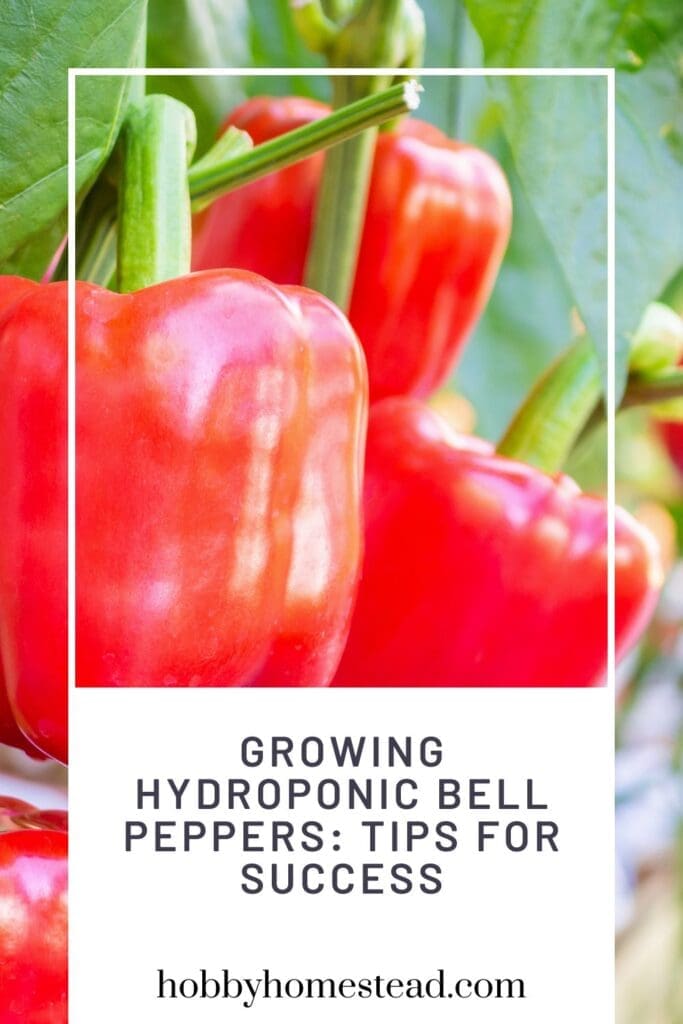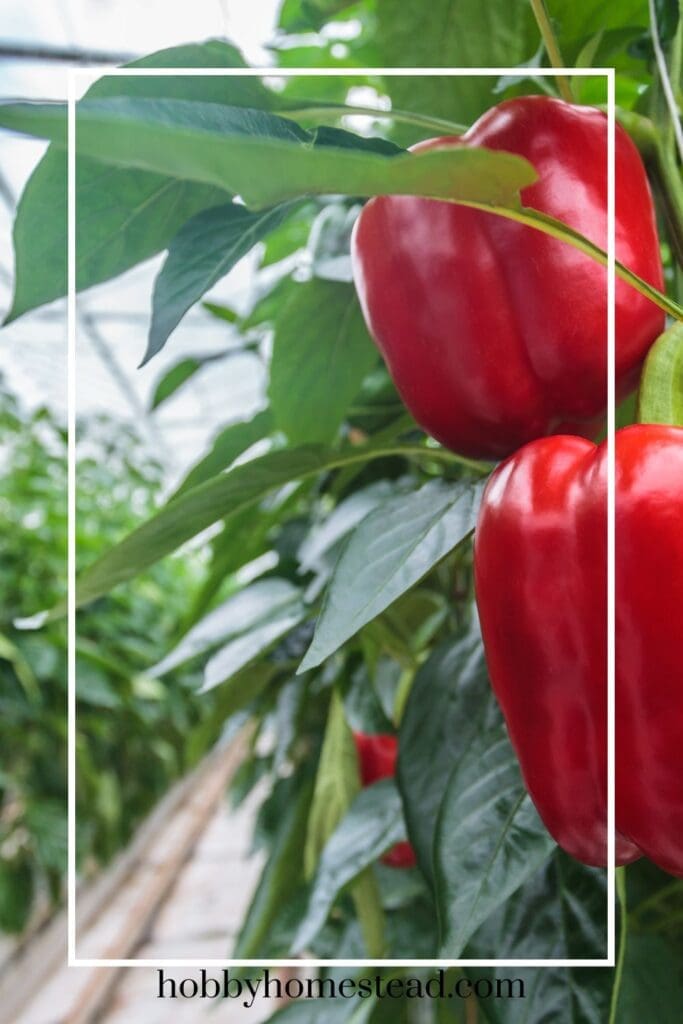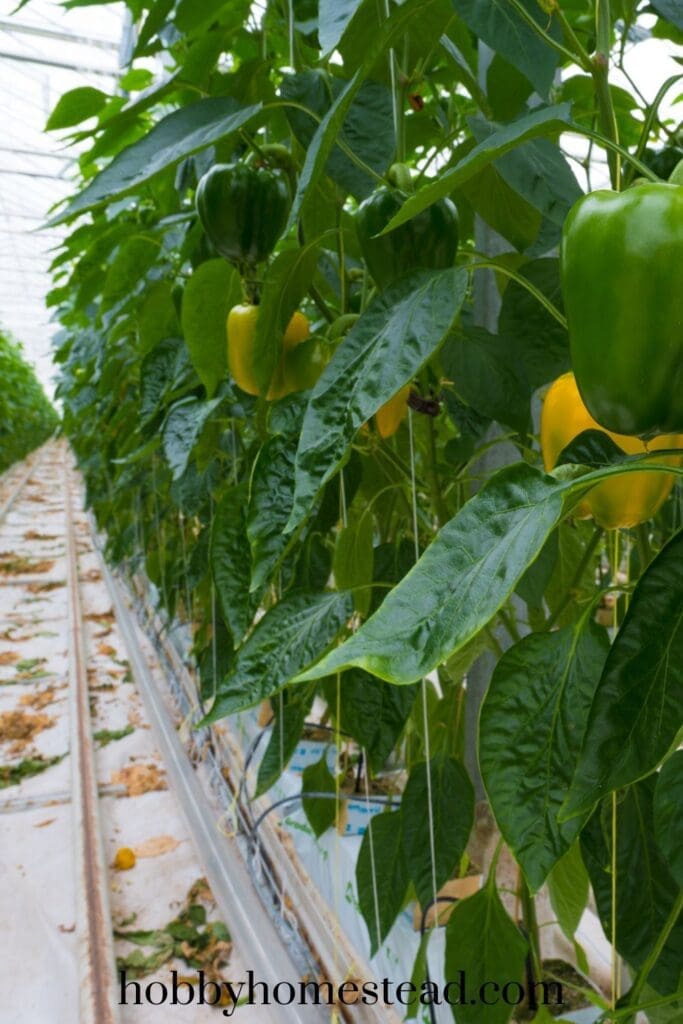One of the most popular choices among home gardeners is hydroponic bell peppers. Hydroponic gardening is a great way to grow fresh vegetables at home, even if you don’t have a lot of space. Whether you’re growing green bell peppers, sweet peppers, or even chili peppers, a hydroponic system offers precise control over environmental conditions, resulting in higher yields and a bountiful harvest of peppers.
Why Choose Hydroponic Bell Peppers?
Hydroponic cultivation provides a controlled environment for your bell pepper plants, which helps you avoid many of the issues found in traditional soil gardening. You can easily manage nutrient levels, pH levels, water temperature, and humidity levels. This control results in optimal growth, faster plant development, and fruit production that’s hard to beat.
Compared to their soil-grown counterparts, hydroponic peppers have better nutrient absorption and improved nutritional value—and you’ll likely enjoy a longer growing season.

Table of contents
- Why Choose Hydroponic Bell Peppers?
- Equipment Needed for Great Success
- Best Hydroponic Systems for Peppers
- Starting Your Hydroponic Peppers: Seeds vs. Clones
- Starting from Sweet Pepper Seeds
- Starting from Clones
- Choosing the Best Growing Medium for Hydroponic Bell Peppers
- How to Prepare and Maintain Your Growing Medium for Hydroponic Bell Peppers
- Caring for Your Hydroponic Bell Peppers
- Flowering, Pollination, and Fruiting
- Additional Tips for Success
Equipment Needed for Great Success
Setting up your grow area with the right tools will help you succeed:
- LED grow light for proper light intensity and meeting light requirements
- Grow tray and net pots
- Air pump and tubing
- pH meter and nutrient kit
- Nutrient recipe or pre-mixed nutrient solution
- Growing medium such as peat moss, rockwool, or soilless mix
- Plastic bags for humidity domes during germination
Keeping fresh water available and monitoring water quality is one of the most important things you can do for healthy plant growth.
Best Hydroponic Systems for Peppers
There are several systems that work well for growing a wide variety of peppers in a hydroponic setup:
- Deep Water Culture (DWC) – Great for beginners. Plants grow in a grow tray with roots suspended in nutrient-rich water, aided by an air pump.
- Nutrient Film Technique (NFT) – Uses a shallow stream of nutrients flowing over the plant roots, allowing for excellent oxygenation.
- Drip System – Delivers a balanced nutrient solution directly to the growing medium, often a soilless mix like peat moss or rockwool cubes.
- Wick System – Simple and passive, but not ideal for larger plants like mature bell peppers.
- Aquaponic System – A more complex hybrid using fish waste as an organic solution for plant nutrients.
Each hydroponics system has pros and cons, but for best results, the DWC and drip irrigation systems are good choices for bell pepper growers.
Starting Your Hydroponic Peppers: Seeds vs. Clones
You can start your own hydroponic peppers two main ways:
- Sweet pepper seeds or chilli pepper seeds: Use rockwool cubes and a heat mat to speed up germination. This gives your peppers a strong head start.
- Clones: A good idea if you want consistent quality and faster growth.
Make sure the water level is just right to encourage root development without drowning the seedlings.
When it comes to growing your own hydroponic bell peppers, there are two reliable ways to get started: from seeds or clones. Both methods can lead to a bountiful harvest of peppers, but the best choice depends on your experience level, your system setup, and how much control you want over the growing process.
Starting from Sweet Pepper Seeds
Growing from sweet pepper seeds (or hot pepper varieties like chili peppers and banana peppers) is a great way to get a head start on your hydroponic gardening journey.
Advantages of Starting from Seeds:
- You can choose from a wide variety of peppers, including heirloom and specialty types.
- It’s generally more affordable than purchasing clones.
- It’s ideal for growers who want to start from scratch and experience the full life cycle of the plant.
How to Start Seeds for Hydroponic Cultivation:
- Germination. Begin by placing seeds in a moist, sterile growing medium such as rockwool cubes or peat moss. Keep the cubes in a warm location with high humidity—using a heat mat and plastic bag or dome can help maintain optimal conditions.
- Water Temperature. Use fresh water at a moderate temperature (not cold water) to encourage sprouting.
- Light Requirements. Once seeds sprout, place them under a LED grow light with sufficient light intensity to promote strong plant growth.
- Nutrients. Start feeding a balanced nutrient solution at half strength once the first true leaves appear. Be sure to monitor pH levels, nutrient levels, and water quality closely.
Growing from seed gives you precise control over your plants’ environment and helps develop strong plant roots right from the beginning.
Starting from Clones
Clones are cuttings taken from mature bell pepper plants that are then rooted and grown into new plants. This method is commonly used by more experienced bell pepper growers or those with access to healthy mother plants.
Benefits of Using Clones:
- Faster fruit production since the clone skips the germination and early seedling stages.
- Clones retain the exact characteristics of the parent plant, making them good choices for maintaining specific traits.
- Useful when growing peppers with a long length of the growing season, like some green bell peppers and mini bell peppers.
How to Root and Start Clones:
- Select a healthy cutting from a mature pepper plant.
- Dip the cutting in rooting hormone and insert it into a moist soilless mix or rockwool cube.
- Keep the humidity high using a humidity dome or plastic cover.
- Use a grow tray with good drainage to prevent rot.
- After roots develop, transfer the clone into your main hydroponic system, whether that’s deep water culture, drip system, or nutrient film technique.
Make sure the environmental conditions—including humidity levels, light requirements, and nutrient regimen—are kept steady to support optimal growth during this transition.
Which Method Is Best for You?
- If you’re new to hydroponic technology, starting with seeds might be the best way to learn and explore hydroponic cultivation from the ground up.
- If you have access to healthy plants and want a faster route to harvest, clones can give you a jumpstart and higher yields.
Either way, both seeds and clones can thrive in a controlled environment, especially with proper use of air pumps, drip irrigation, and hydroponic systems tailored to bell pepper plants. With the right setup and care, you’ll be growing delicious sweet peppers, green peppers, and even spicy chilli peppers in no time!
Choosing the Best Growing Medium for Hydroponic Bell Peppers
Selecting the right growing medium is a good idea to ensure strong plant growth and optimal conditions for your hydroponic bell peppers. Since hydroponics involves a soilless mix, the medium supports the plant roots, holds moisture, and allows for good oxygen flow.
Popular Growing Media Options
Rockwool Cubes
- One of the most important factors for success, rockwool offers excellent water retention and good drainage.
- It’s widely used in hydroponic cultivation because it provides a stable, sterile environment for sweet pepper seeds and mature plants.
- Rockwool has a neutral pH and is compatible with most nutrient recipes.
Peat Moss
- Peat moss is a good choice for holding moisture while still allowing airflow.
- It works well combined with perlite or vermiculite to improve aeration.
- It’s a great way to start seeds or young plants and supports healthy nutrient absorption.
Coconut Coir
- An eco-friendly, renewable option, coconut coir offers excellent water retention and good aeration.
- It’s resistant to compaction, making it easier for roots to grow and absorb nutrients.
- Works well with a balanced nutrient regimen and maintains optimal growth conditions.
Perlite and Vermiculite
- Often mixed with other media, perlite and vermiculite improve drainage and aeration.
- They help prevent waterlogging, which is essential to avoid root rot in hydroponic systems.
Expanded Clay Pellets (Hydroton)
- These lightweight, inert pellets provide excellent aeration and drainage.
- They’re reusable and don’t affect pH, making them a popular option for hydroponic gardening.
What to Consider When Choosing a Medium
- Water Retention and Drainage. The medium must hold moisture but provide good drainage to prevent waterlogged roots.
- Aeration. Oxygen around the roots is critical for nutrient absorption and overall plant growth.
- pH Neutrality. A balanced nutrient solution is easier to maintain if your growing medium doesn’t alter pH.
- Sterility. Using sterile or inert mediums like rockwool or clay pellets helps avoid pathogens and pests such as spider mites.
- Compatibility with Your Hydroponic System. Different systems like deep water culture, nutrient film technique, or drip system may favor different media for best results.
Choosing the right growing medium sets a strong foundation for your hydroponic bell peppers to thrive, leading to higher yields and great success with your own hydroponic peppers.
How to Prepare and Maintain Your Growing Medium for Hydroponic Bell Peppers
Choosing the right growing medium is just the first step. Proper preparation and maintenance ensure your bell pepper plants get the essential nutrients and optimal conditions for healthy plant growth and fruit production.
Preparing Your Growing Medium
Sterilize the Medium
- Whether you’re using rockwool cubes, coconut coir, peat moss, or expanded clay pellets, it’s important to start with a clean, sterile medium.
- Rinse thoroughly with fresh water to remove dust and debris. For reusable media like clay pellets, soak and rinse well; consider soaking in a mild hydrogen peroxide solution to reduce pathogens.
- This helps prevent diseases like root rot and pests such as spider mites from establishing.
Adjust pH Levels
- Most hydroponic bell peppers thrive in a slightly acidic pH between 5.5 and 6.5. Before planting, check the pH of your medium with a test kit.
- Soak or rinse your medium in a pH-balanced solution if necessary to ensure optimal growth conditions.
Pre-Wet the Medium
- Soak your growing medium with fresh water or a diluted balanced nutrient solution before planting.
- This saturates the medium, supporting immediate nutrient absorption by the plant roots.
Maintaining Your Growing Medium
Monitor Moisture and Drainage
- The medium should be moist but never waterlogged.
- Good drainage prevents oxygen depletion in the root zone, reducing the risk of root rot.
- Systems like drip irrigation or nutrient film technique help maintain this balance by providing consistent moisture.
Maintain Nutrient Levels
- Regularly flush the medium with a fresh nutrient regimen to prevent salt buildup, which can inhibit nutrient uptake.
- Use a nutrient kit to monitor and adjust nutrient levels and pH levels in your hydroponic system.
Inspect for Compaction
- Over time, some growing media like peat moss or coconut coir may compact, reducing aeration.
- Gently loosen the medium if possible, or replace it periodically to maintain a healthy soilless mix environment.
Prevent Pathogen Buildup
- Keep the grow area clean.
- Don’t let dead roots or plant debris accumulate in the medium.
- Periodically sanitize reusable media and equipment with safe, organic solutions like diluted hydrogen peroxide.
Manage Environmental Factors
- Maintain proper humidity levels, light intensity, and temperature to support the medium’s function and overall plant health.
- Use led grow lights and an open shade structure if growing indoors or in controlled environments.
Proper care of your growing medium in your hydroponics system is one of the most important things you can do for successful hydroponic cultivation of sweet peppers and hot peppers alike. Healthy roots in a well-maintained medium mean bigger, better peppers — whether you’re growing mini bell peppers, banana peppers, or chili peppers!
Caring for Your Hydroponic Bell Peppers
Once your plants are established, you’ll need to maintain optimal conditions to ensure healthy plant growth and fruit production:
- Keep pH levels between 5.8 and 6.3 for ideal nutrient absorption.
- Follow a nutrient regimen that includes all essential nutrients (especially calcium to prevent blossom end rot).
- Use hydrogen peroxide occasionally to prevent root rot and sanitize the system.
- Watch out for spider mites and treat infestations quickly.
- Prune to remove unnecessary leaves, promote airflow, and support larger plants.
- Use horizontal wires or plant stakes to support tall or heavy plants.

Flowering, Pollination, and Fruiting
For great success with pepper production, mimic nature when growing indoors:
- Once flowers appear, use hand pollination (a soft brush or gentle shake) to encourage fruit production.
- During the flowering and fruiting stage, slightly reduce nitrogen and increase potassium in your nutrient solution.
- Make sure your light intensity and humidity levels support healthy blooms.
Pruning and Flower Management for Bigger Peppers
Pruning your bell pepper plants in a hydroponic system is one of the most important factors for encouraging strong plant growth and producing larger fruit instead of a high number of small peppers.
Here’s how and why to do it:
Why Prune Hydroponic Peppers?
- Pruning helps focus the plant’s energy on fruit production rather than excess foliage.
- It improves airflow around the plant roots and branches, reducing the risk of pests like spider mites and fungal diseases.
- It supports healthier, larger plants in your grow area.
When and How to Prune
- Begin pruning when the plant is about 8–10 inches tall and has a strong main stem.
- Remove lower leaves and any leaves that touch the growing medium (such as rockwool cubes or peat moss) to improve air circulation.
- Pinch off suckers (small shoots growing between the main stem and branches), especially on young plants.
Removing Early Flowers
- For the best results, it’s a good idea to remove the first round of flowers that appear on young plants. This helps the plant invest energy in developing a strong root system and sturdy stem structure.
- Once the plant is more mature, allow flowering and use hand pollination to encourage fruit production.
Managing Flowering for Larger Fruit
- After the plant starts producing peppers, limit the number of flowers you allow to mature at one time.
- Fewer fruits per plant = larger, healthier peppers.
- This is especially helpful when growing sweet peppers, mini bell peppers, or chili peppers in systems like deep water culture or drip irrigation.
By carefully managing pruning and flowering, you support optimal growth, nutrient absorption, and more flavorful, fully developed hydroponic bell peppers.
Hand Pollination for Hydroponic Bell Peppers
In hydroponic gardening, especially when growing bell pepper plants indoors or in a controlled environment like a grow tray under LED grow lights, natural pollinators such as bees or wind may not be available. This makes hand pollination a crucial step to ensure successful fruit production and a bountiful harvest of peppers.
Why Hand Pollination is Important
- Without natural pollinators, flowers may not get fertilized, resulting in poor fruit set or no peppers at all.
- In hydroponic systems like deep water culture, nutrient film technique, or drip irrigation, airflow is often limited, reducing the chances of natural pollination.
- Hand pollination gives you precise control over fertilization, improving the quality and quantity of your hydroponic bell peppers and chili peppers.
When to Hand Pollinate
- Pollination should happen when flowers are fully open and receptive, usually in the morning when humidity levels are moderate.
- Mature plants will typically produce multiple flowers at once, and regular pollination helps maximize fruit production.
How to Hand Pollinate Hydroponic Bell Peppers
- Identify the Flowers. Look for freshly opened blossoms on your sweet pepper seeds plants or other specific types like banana peppers or mini bell peppers.
- Use a Small Brush or Cotton Swab. Gently brush the inside of each flower to transfer pollen from the male parts (anthers) to the female parts (stigma). This mimics the action of bees.
- Shake the Plant Gently. Alternatively, you can softly shake the plants or tap the flowers to release pollen and promote pollination between flowers on the same plant or neighboring plants.
- Repeat Regularly. To ensure good fruit set, repeat the process every few days during the flowering period.
Additional Tips for Success
- Maintain optimal growth conditions like warm temperatures and stable humidity levels to help flowers stay healthy and receptive.
- Keep your nutrient regimen balanced, ensuring your hydroponic system delivers all the essential nutrients and maintains correct pH levels for strong flowering and fruit development.
- Use hydrogen peroxide occasionally to improve water quality and reduce the risk of disease during this delicate stage.
- In some setups, a gentle fan can help simulate natural airflow, aiding pollination and reducing pest issues like spider mites.
Benefits of Hand Pollination
- Helps prevent issues like blossom end rot by ensuring well-pollinated, healthy fruit.
- Supports larger plants to produce higher yields of green bell peppers, sweet peppers, and hot peppers.
- Offers a good way to improve success in hydroponic cultivation where outdoor conditions or natural pollinators aren’t accessible.
Hand pollination might sound like extra work, but it’s one of the most important things you can do for your hydroponic bell peppers. With a little practice, it becomes quick and simple—and it dramatically improves your chances for a bountiful harvest of peppers!

Tips for Harvesting and Beyond
- Harvest green peppers early for a mild taste or wait for them to fully ripen to red, yellow, or orange depending on the specific types or different varieties of pepper you’re growing.
- Consider growing mini bell peppers, hot peppers, or banana peppers to diversify your harvest.
For best way to extend your harvest and keep plants producing, harvest frequently and avoid overloading the branches.
How can I prevent root rot in hydroponic sweet peppers?
Root rot is a common problem in hydroponic gardening that can severely affect your bell pepper plants, including green bell peppers and sweet peppers. It’s caused by harmful pathogens thriving in stagnant, oxygen-poor water around the plant roots. Here’s how to keep your roots healthy:
1. Maintain Proper Water Temperature
- Keep the water temperature between 65°F and 75°F (18°C – 24°C). Warm water holds less oxygen, so avoid temperatures above this range to ensure adequate oxygen levels.
- Use a heat mat or cooling systems if necessary to stabilize water temperature in your deep water culture or nutrient film technique systems.
2. Ensure Good Aeration with Air Pumps
- Use an air pump to supply oxygen-rich air bubbles to the hydroponic system.
- Proper aeration is critical because plant roots need oxygen for nutrient absorption and to prevent anaerobic conditions that promote root rot.
3. Monitor Water Quality and Nutrient Levels
- Regularly check and maintain pH levels (typically between 5.5 and 6.5 for sweet peppers).
- Keep the nutrient regimen balanced, avoiding excess nitrogen that can stress roots.
- Change your nutrient solution frequently to prevent buildup of pathogens and harmful microbes.
4. Use Hydrogen Peroxide as a Preventative Treatment
- Adding a low concentration of hydrogen peroxide to your water can help kill root pathogens without harming your plants.
- This organic solution is a good choice for controlling root rot in hydroponic bell peppers.
5. Keep the Growing Medium and Equipment Clean
- Whether you use rockwool cubes, peat moss, or other soilless mix growing media, sterilize it before planting.
- Clean grow trays, tubing, and reservoirs regularly to avoid contamination.
6. Provide Good Drainage and Avoid Water Stagnation
- Ensure your drip irrigation or nutrient film technique systems have proper drainage and water flow.
- Avoid cold water or water sitting still for long periods, which can lower oxygen and increase disease risk.
Maintain Optimal Environmental Conditions
- Keep humidity levels balanced to reduce fungal growth.
- Prevent overwatering and allow the plant roots to breathe in systems like wick systems or grow trays.
By following these steps, you’ll create a controlled environment that supports healthy roots, leading to great success in your hydroponic cultivation of sweet peppers. Healthy roots mean vigorous plant growth, strong fruit production, and a tasty bountiful harvest of peppers.
Why Are the Fruits on My Sweet Pepper Plants Splitting?
Fruit splitting in hydroponic bell peppers—including green peppers and sweet peppers—is often caused by uneven water uptake or fluctuations in environmental conditions. Here’s what’s usually behind it:
1. Inconsistent Watering or Nutrient Delivery
- Sudden changes in water availability—like letting the nutrient film technique or deep water culture system dry out and then flooding again—can cause peppers to absorb water too quickly.
- This rapid water intake makes the fruit swell faster than the skin can stretch, leading to splits or cracks.
2. Fluctuations in Humidity and Temperature
- Peppers grown in hydroponics thrive in optimal conditions, including stable humidity levels and warm temperatures.
- Sudden changes, especially spikes in heat or drops in humidity, stress the plant and can cause the fruit skin to split.
3. Excessive Nutrient Levels
- Overfeeding, especially too much nitrogen or inconsistent nutrient levels, can lead to rapid growth and weaker skin development.
- A balanced nutrient regimen and proper monitoring of pH levels are important to avoid this.
4. Genetic Factors and Variety
- Some specific types or different varieties of pepper, like certain hot peppers or mini bell peppers, are more prone to splitting.
- Choosing popular choices known for thicker skins can reduce this problem.
How to Prevent Fruit Splitting
- Maintain a balanced nutrient solution with steady and consistent delivery in your hydroponic system (whether it’s drip system, nutrient film technique, or deep water culture).
- Keep your water quality high with fresh water and regularly check water temperature to avoid extremes.
- Control humidity levels and environmental conditions within your open shade structure or indoor grow space.
- Practice careful monitoring of light intensity and nutrient absorption to support strong fruit development.
- Consider pruning some flowers or smaller fruits early on to help the plant focus on developing fewer, larger fruits with thicker skins.
- Use hand pollination to improve fruit production consistency, reducing stress on the plant.
By keeping your hydroponic bell peppers in controlled environment conditions with steady water, nutrients, and temperature, you can reduce the risk of fruit splitting and enjoy a bountiful harvest of peppers with great nutritional value.
Planning for Growing Success
Using hydroponic technology to grow bell peppers is a great way to enjoy energy efficiency, faster growth, and a longer length of the growing season. With proper care, attention to nutrient levels, and a focus on environmental conditions, your hydroponic gardening efforts can yield peppers just as tasty (or even tastier) than their soil-grown cousins.
Whether you’re working under an open shade structure or inside a compact grow tent, hydroponic cultivation gives you the power to produce fresh, flavorful peppers right at home—no lot of space needed!
References
Agrotronics. Growing Bell Peppers in Hydroponics – A Guide.
LePot. How to grow Hydroponic Bell Peppers indoors: A Detailed Guide.


